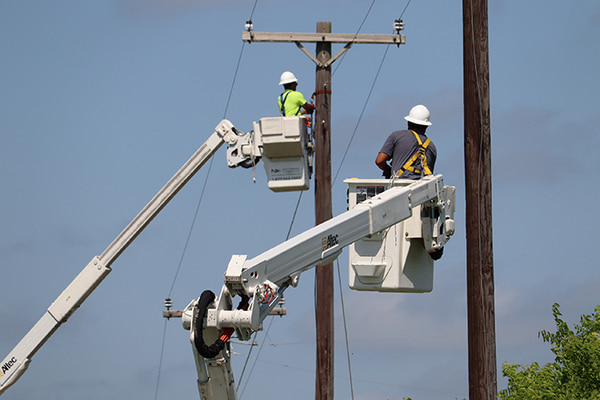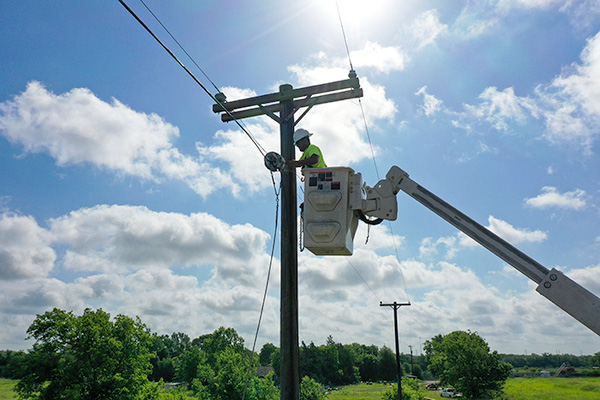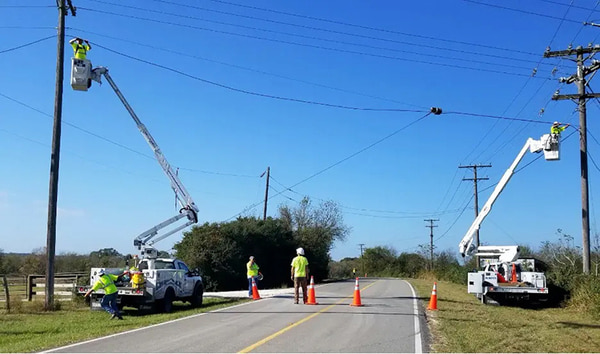Aerial Lineman: Masters and Guardians of Telecommunications and the Grid – Part II
The following is Part 2 in a series of blogs about Aerial Lineman.
You can find a link to Part 1 at the bottom of this blog.
Training Comparison
The training and timeline for becoming a telecommunications lineman can vary depending on the specific requirements and programs available in a particular region. However, the training duration for a aerial lineman is often shorter compared to becoming an electrical lineman. Here are some factors to consider:
Telecommunications Lineman
Training Duration: The training period for a telecommunications lineman can range from a few months to a year, depending on the training program. Some programs offer intensive courses that focus specifically on the skills and knowledge required for working in the telecommunications industry.

Skill Emphasis: Telecommunications lineman training primarily focuses on skills related to installing, maintaining, and repairing communication lines, such as fiber optic cables and coaxial cables. The training covers topics like splicing fiber optics, working with different types of connectors, understanding signal transmission, and utilizing specialized equipment for testing and troubleshooting.
Prior Experience: While not always required, having a background in electrical or electronics-related fields can be beneficial when training to become a aerial lineman. Previous experience in areas like networking, telecommunications, or electronics can help individuals grasp concepts more quickly.
National OnDemand provides an Aerial Lineman School so our crews are trained and ready when called upon to offer our fiber services to clients.
Electrical Lineman:
Training Duration: Becoming an electrical lineman typically involves a more extensive training period due to the broader scope of work and the complexity of working with high-voltage electrical systems. The training can range from a few years in an apprenticeship program to a combination of classroom instruction and on-the-job training.
Skill Emphasis: Electrical lineman training covers a wide range of skills related to power distribution and transmission systems. This includes working with high-voltage power lines, transformers, substations, and other electrical equipment. The training focuses on safety protocols, climbing techniques, electrical theory, troubleshooting, and working with various types of conductors and insulators.
Licensing and Certification: In many regions, electrical linemen are required to obtain specific licenses or certifications to perform electrical work. These requirements may add additional time to the overall training process.
It’s important to note that the specific requirements, training programs, and duration can vary between different regions and countries. Additionally, both telecommunications and electrical linemen often continue their education and skill development throughout their careers to stay updated with advancements in their respective fields. The training duration for a telecommunications lineman is often shorter compared to becoming an electrical lineman due to the narrower focus on communication infrastructure. However, the exact timeline can vary based on the training program, prior experience, and specific regional requirements.

Training
The duration of training required to become an aerial lineman can vary depending on the specific training program and the individual’s prior experience. Typically, employees from National OnDemand are offered training at our aerial lineman school, preparing them to enter the field prepared to get the job done.
Apprenticeship Programs: One common path to becoming an electrical aerial lineman is through participation in an apprenticeship program. These programs typically last between three to four years. Apprentices receive a combination of on-the-job training and classroom instruction. During this period, they gradually learn the skills required for the aerial lineman job, including climbing techniques, equipment operation, safety protocols, electrical theory, and system maintenance.
Pre-Apprenticeship Programs: Some aspiring linemen may choose to enroll in pre-apprenticeship programs before entering formal apprenticeships. These programs provide a foundation in basic electrical principles, safety practices, and physical fitness training. Pre-apprenticeship programs can vary in duration, ranging from a few weeks to several months. Apprenticeships are not typically required for telecommunication lineman careers.
Prior Experience and Education: Individuals with prior experience or relevant educational backgrounds may have a head start in the training process. For example, those with degrees or certifications in electrical engineering or related fields may have a deeper understanding of electrical systems and could potentially accelerate their training timeline.
It’s important to note that becoming a proficient aerial lineman is a continuous learning process. Even after completing the initial training, linemen continue to expand their skills and knowledge throughout their careers to keep up with advancements in technology and industry standards.
Regarding the transition from training to starting work, many apprenticeship programs include periods of on-the-job training where apprentices work under the supervision of experienced electrical linemen. Once apprentices have completed their training and demonstrated competency in their skills, they are typically eligible to start working as full-fledged aerial linemen. This transition can occur immediately after the apprenticeship program or shortly after, depending on the availability of job openings and the employer’s requirements.
Overall, the training period, including apprenticeship and any pre-requisite education, can range from several weeks for a telecommunications lineman to a few years for an electrical lineman before an individual can start working as an aerial lineman.
The job market for aerial linemen was generally favorable due to the ongoing demand for skilled workers in the power distribution and telecommunications industries. However, please note that the job market can vary over time and in different regions. It is recommended to consult up-to-date sources, industry reports, and local employment agencies to obtain the most accurate and current information on the job market for aerial linemen.
Factors that contribute to the positive job market for Aerial Lineman include:
Infrastructure Development: The expansion and maintenance of power distribution and communication networks require the expertise of aerial linemen. As communities grow and new infrastructure projects are undertaken, there is an ongoing need for qualified professionals to install, repair, and maintain overhead systems.
Aging Workforce: In many countries, there is a significant portion of the workforce in the power and telecommunications sectors nearing retirement age. This creates job opportunities for new entrants to fill the positions left vacant by retiring linemen.

Technological Advancements: The advancement of technology in the utility and telecommunications industries continually presents new challenges and opportunities. Aerial linemen with up-to-date skills and knowledge in areas such as fiber optics, smart grids, and renewable energy systems may be particularly sought after.
Emergency Response and Disaster Recovery: Aerial linemen play a crucial role in restoring power and communication services during emergencies, natural disasters, and unforeseen events. The need for skilled linemen in disaster-stricken areas is often high, leading to increased employment opportunities.
Rural Electrification Initiatives: Many regions are striving to expand access to electricity and communication services in rural and remote areas. This expansion effort requires skilled aerial linemen to extend and maintain infrastructure in these underserved regions.
It is essential to consider that regional variations and economic conditions can impact the job market. Therefore, conducting thorough research specific to your desired geographic area will provide the most accurate and up-to-date information on the current job market for aerial linemen. Additionally, reaching out to local utility companies, trade associations, and professional networks can help gather insights on job prospects and potential opportunities in the field.
You can find all our current openings on our careers page.
Click here for Part 1 in the series of blogs about Aerial Lineman

